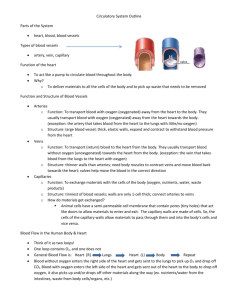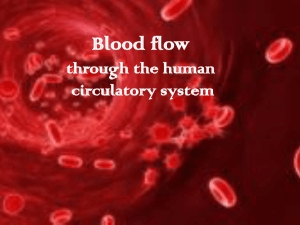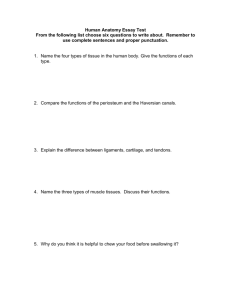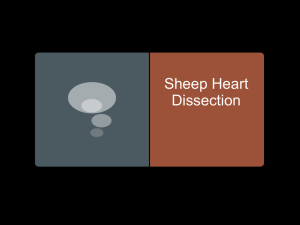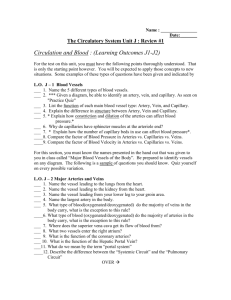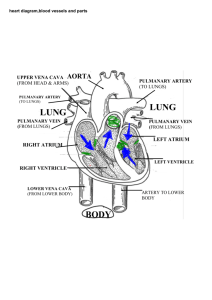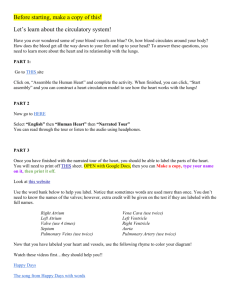Lesson 2: Human Body Systems – The Circulatory System To
advertisement
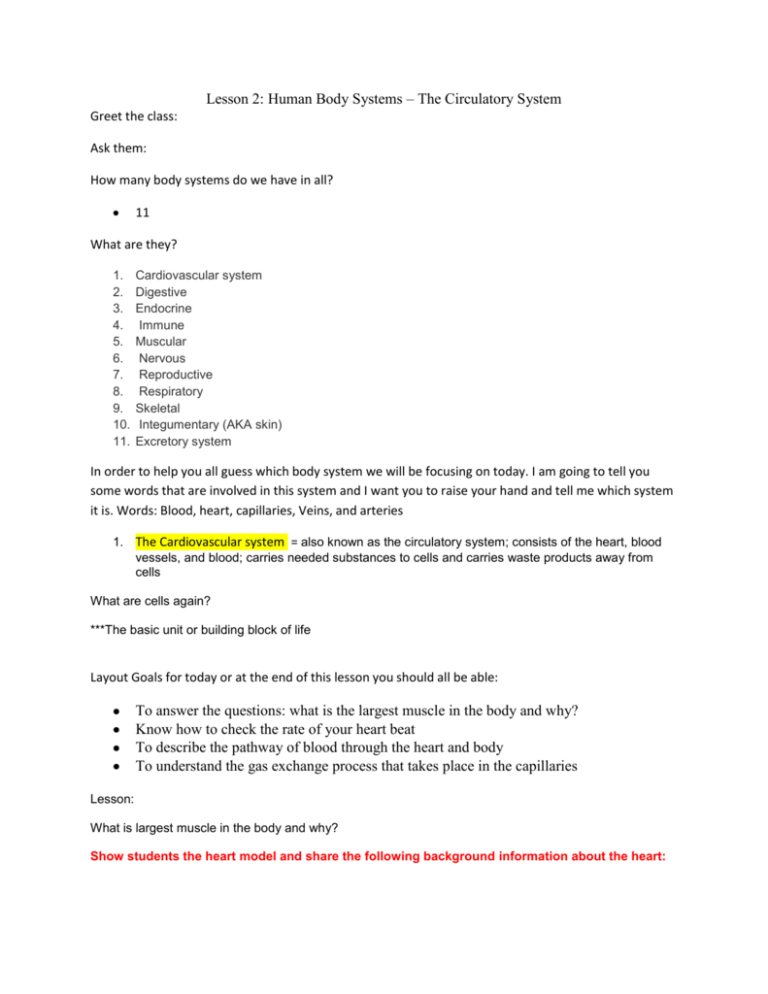
Lesson 2: Human Body Systems – The Circulatory System Greet the class: Ask them: How many body systems do we have in all? 11 What are they? 1. 2. 3. 4. 5. 6. 7. 8. 9. 10. 11. Cardiovascular system Digestive Endocrine Immune Muscular Nervous Reproductive Respiratory Skeletal Integumentary (AKA skin) Excretory system In order to help you all guess which body system we will be focusing on today. I am going to tell you some words that are involved in this system and I want you to raise your hand and tell me which system it is. Words: Blood, heart, capillaries, Veins, and arteries 1. The Cardiovascular system = also known as the circulatory system; consists of the heart, blood vessels, and blood; carries needed substances to cells and carries waste products away from cells What are cells again? ***The basic unit or building block of life Layout Goals for today or at the end of this lesson you should all be able: To answer the questions: what is the largest muscle in the body and why? Know how to check the rate of your heart beat To describe the pathway of blood through the heart and body To understand the gas exchange process that takes place in the capillaries Lesson: What is largest muscle in the body and why? Show students the heart model and share the following background information about the heart: The heart is the largest muscle in the body because the heart has to be able to pump blood throughout the entire body and back to the heart again. Heart = a hollow, muscular organ that pumps blood throughout the body; some additional fun facts about the heart: - It is about the size of your fists - Located in the center of your chest - The heart is made out of cardiac muscle so it can contract (tighten or squeeze) over and over again without getting tired - The heart works day and night to pump blood through the cardiovascular/ circulatory system. - The heart consists of two pumps - The pump on the right side of the heart sends blood to the lungs where the blood obtains oxygen. - The blood which has obtained oxygen then travels back to the heart where it is pumped to all parts of the body. What does your heart look like? Or What is the structure of a heart? Is it a “heart” shape? - No Not a “heart” shape but more of an irregular shape The heart has two sides: a right side and a left side that are completely separated from each other by a wall of tissue called the septum. Each side (left and right) is then separated by valves to form 2 chambers on: an upper and a lower chamber o Upper/smaller chambers = atrium o Lower/bigger chambers = ventricles Draw on board: Summarize heart structure as four quadrants right now: Top Right = right atrium Top Left = left atrium Bottom Right = right ventricle Bottom Left = left ventricle Explain Heart Model Activity: At this station you will label the heart parts and observe them in an actual heart model. Also write at least 3 facts about the heart. How does blood get from our heart to the toes or fingers? What do they travel in? - I’ll give you a hint..try placing your hand below or lower than your heart or down to your side-- where is your heart? - Point to your heart Show and explain to students how to do this: As you place your hands at a lower elevation than their heart you will see that the veins pop out or become more visible because when your hands or any body part including your head is at a lower elevation than your heart then blood will automatically rush there. - EXAMPLE: when you are hanging upside down on the monkey bars your face turns red because blood is rushing there. SO how does blood travel in our body? Blood does not float around freely in our body but rather blood travels through these tubes that look like tunnels called blood vessels. Each time the heart beats, it pushes blood through the blood vessels of the cardiovascular system. There are 3 types of blood vessels: 1. Veins – blood vessels that carry blood back to the heart 2. Artery – blood vessels that carry blood away from the heart - think A for Away 3. Capillaries – the place where substances are exchanged between the blood and body cells As blood is being pumped or pushed through arteries, you can feel the artery walls stretch and relax. Show them how to do this as I am explaining: You can feel this action when you place two fingers on your neck. You feel a beating. What is this called? A pulse = the number of times your heart beats in a minute; it's your heart rate. So how can we measure our heart rate? - answer = based on pulse definition ** students should be brainstorming - We can all measure our heart rate by measuring our pulse which is counting the number of times our heart beats in one minute - definition of pulse Explain pulse activity with stethoscope BUT not letting them do it yet b/c gonna break up room in half for 2 different activities: Procedures: Student Information: 1. Have the students pair up and listen for their partner's heartbeat by placing the tube over the partner's heart. 2. Count the number of beats per minute to find out how many times each minute the person's heart beats = resting/initial heart rate 3. Have one partner run in place as fast as they can for 30 sec or do 15 jumping jacks for one minute, then listen again. Have the students write down what they hear and calculate the new beats per minute = subtract your resting/initial heart rate from the final heart rate 4. Have the partners switch. Now, Pass out vocab sheet and then split room in half and let the students do the 2 activities (20 minutes). After activities- Discussion: In the pulse activity, what did you notice about your initial and final pulse? - Which one was slower? - resting/initial heart rate Which was faster?- final heart rate Why?- b/c the heart will beat faster after any exercise or active activities that you do in order to pump more blood to the working muscles. Now focus = Understanding how the heart works and the pathway of blood through the entire body What kind of sound does your heart make when it is pumping blood? ** Lub- Dup Why does our heart make this sound? It makes this sound because of the pathway/movement of blood causing the valves to open and close. Pathway of blood: 1. When the heart muscles relax, deoxygenated blood (= oxygen poor blood has a lot of Carbon dioxide but very little oxygen) will flow into the right atrium. 2. Then the heart will contract to squeeze the blood out of the right atrium through the valves into the right ventricle 3. this contraction is going to open the valve between the atrium and ventricle very quickly, making the lub sound. Also with this contraction, it is going to squeeze and push the blood through an artery that is connected from the heart to the lungs.- But then the valve will quickly close up to make the Dup sound- 4. (At this point the blood is STILL deoxygenated) - The deoxygenated blood moves through the artery to the lungs where there is a capillary. In the capillary is where the deoxygenated blood is going to be exchanged to oxygenated blood or more in particular: where the exchange of carbon dioxide for oxygen takes place. 5. The oxygenated blood then flows from the lungs into a vein that is going to dump the oxygenated blood into the left atrium 6. When the heart contracts then the valve will open up allowing the oxygenated blood to flow into the left ventricle 7. Then a powerful contraction takes place to push the blood through another valve (called the aortic valve) to get into the aorta which is where the blood is then sent out throughout the body 8. As the blood circulates throughout the whole body it is going to give away its oxygen to different parts of your body that needs it - now it is deoxygenated - returns back to the heart for the cycle to repeat all over again ****So basically every time the heart contracts you will hear a lub dup sound- the first sound = lub = when the valves open up then the second sound = dup =when the valves close SUMMARY: Draw heart and capillary diagram on the board and re-explain as I show arrows:- have them COPY it on the back of their Vocabulary sheet: The Human Cardiovascular System Activity: 1. Give them signs randomly with words such as: - Oxygenated blood which means what? - has a lot of oxygen - Deoxygenated blood - which means what? has very little oxygen and more carbon dioxide - Capillary in the lungs = where the gas exchange occurs from carbon dioxide (deoxygenated) to oxygen (oxygenated) - Valves = open and close to let blood through - Artery to lungs = connects from heart to lungs - Veins from lungs = connect from lungs to heart - Aorta = largest artery in the body that carries blood from the left ventricle to the body - Capillary in the body = where the gas exchange occur from oxygen (oxygenated) to carbon dioxide(deoxygenated) - Veins from body= connects from wherever in the body to the heart 2. Then have them walk it out and we are going to do this in the gym. How many signs: - - Capillary in the lungs (1) (switches the blood peoples sign from deoxygenated to oxygenated) Valves (2 people hold hands and let go (say lub) and rejoin (dup) when people come by or when there is a contraction) o Right side of heart (2) o Left side of heart (2) o Aortic Valve (2) Artery to lungs (2) (hold hands to form a bridge and act as police in this activity to make sure only deoxygenated blood goes through) Veins from lungs (2) (hold hands to form a bridge and acts a police in this activity to make sure only oxygenated blood goes through) Aorta (2) (hold hands to allow only oxygenated blood to go through and go to body- run around freely and go to capillary in the body) Capillary in the body (1) (switches the blood peoples sign from oxygenated to deoxygenated) Veins from body(2)(hold hands to forma a bridge to allow only deoxygenated blood thru to go to the heart or to the right atrium- cycle repeats or begins all over again) Whoever is left = - Oxygenated blood Deoxygenated blood ** this will be like a tag team system where one person comes and tags another person to go etc… If there is time- Eraser game: Objective: to define key terms and recap on everything we learned Materials: white board with silver bottom part white board earser Procedures: Student Information: 1 This is called “the eraser game”. Divide the board into four pieces and write point values such as farthest end = 100 pts, next region = 75 pts, next region = 25 pts, and last/closet region to the starting point = 15 pts. 2. Separate the class into two teams or by tables (4 or 5 teams) and have one person from each team be the designated speaker and writer. 3. Then ask a question or say a definition and each team has 30 seconds to quietly discuss and write down an answer. 4. After the timer goes off, ask each team to say and show what their answer is. 5. The teams who got it correct get to choose one person to come up and slide the eraser. 6. Where ever region it lands on they get that many points. If it falls off, you get only ONE re-do. Call and ask Ms. Johns: 1. About my own system of behavioral discipline 2. Is it okay to have students sit out on an activity if they are misbehaving but if they say that they will behave then they can come back and join the group 3. Have centers/stations- 2 tables: a. FIRST table = stethoscopes b. SECOND table = Looking at the heart models Vocabulary Words: 1. Cardiovascular System = also known as the circulatory system; consists of the heart, blood vessels, and blood; carries needed substances to cells and carries waste products away from cells 2. Heart = a hollow, muscular organ that pumps blood throughout the body; some additional fun facts about the heart: - It is about the size of your fists - Located in the center of your chest- it lies behind the breastbone (sternum) and inside the ribs, these bones help protect the heart from injury 3. Pulse = the number of times your heart beats in a minute; it is your heart rate 4. Blood vessels = a tubular structure carrying blood through tissues and organs; there are 3 different kinds of blood vessels: a vein, artery, and capillary. 5. Veins = blood vessels that carry blood back to the heart 6. Artery = blood vessels that carry blood away from the heart 7. Capillaries = the place where substances are exchanged between the blood and body cells 8. Atrium = each of the two upper chambers of the heart that receives blood that comes into the heart 9. Ventricle = each of the two lower chambers of the heart that pumps blood out of the heart 10. Valve = a flap of tissue in the heart or a vein that prevents blood from flowing backward 11. Aorta = the largest artery in the body
